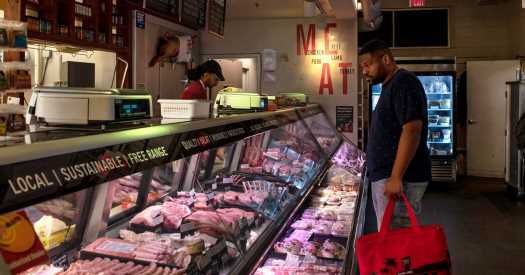Inflation Cools Notably, but It’s a Long Road Back to Normal
WASHINGTON — Inflation moderated notably in March as a decline in gas prices helped to pave the way for the slowest pickup in prices in nearly two years, providing relief for many American consumers and some evidence that the Federal Reserve’s campaign to raise interest rates and cool the economy is beginning to work.
The Consumer Price Index climbed 5 percent in the year through March, down from 6 percent in February. That marked the slowest pace of price increases since May 2021.
But the details of the report underlined that inflation retains concerning staying power under the surface: A so-called core index that aims to get a clearer sense of price trends by stripping out food and fuel costs, both of which can be volatile, picked up by 5.6 percent from a year earlier. That was up slightly from February’s 5.5 percent increase, and it marked the first acceleration in the yearly number since September.
Taken in total, the fresh inflation data suggested that price increases were meaningfully moderating, but that progress remained gradual. And that mixed signal comes during a challenging economic moment for the Fed. The central bank is the government’s main inflation fighter, and it has been trying to wrestle price increases back under control for slightly more than a year, raising interest rates to nearly 5 percent from near zero as recently as March 2022 to slow the economy and weigh down costs.
Officials are now assessing how their policy changes are working, and they are trying to gauge whether they need to do more to ensure that price increases will come fully under control. Inflation has been decelerating after peaking at about 9 percent last summer, but the process has been slow. It remains a long way back to the 2 percent inflation that was normal before the onset of the pandemic in 2020.
Uncertainty over how quickly and completely price increases will cool is being compounded by recent developments. A series of high-profile bank blowups last month could restrain the economy, but it is unclear by how much. Some Fed officials are urging caution in light of the turmoil, even as others warn that the central bank should keep its foot on the economic brake and remain focused on its fight against rising prices.
The new data probably “solidifies the case for the Fed to do another hike in May, and to proceed cautiously from here,” said Blerina Uruci, chief U.S. economist at T. Rowe Price. She said the fresh report offered good news, but “it will take time to bring inflation down.”
Inflation F.A.Q.
What is inflation? Inflation is a loss of purchasing power over time, meaning your dollar will not go as far tomorrow as it did today. It is typically expressed as the annual change in prices for everyday goods and services such as food, furniture, apparel, transportation and toys.
What causes inflation? It can be the result of rising consumer demand. But inflation can also rise and fall based on developments that have little to do with economic conditions, such as limited oil production and supply chain problems.
Is inflation bad? It depends on the circumstances. Fast price increases spell trouble, but moderate price gains can lead to higher wages and job growth.
How does inflation affect the poor? Inflation can be especially hard to shoulder for poor households because they spend a bigger chunk of their budgets on necessities like food, housing and gas.
Can inflation affect the stock market? Rapid inflation typically spells trouble for stocks. Financial assets in general have historically fared badly during inflation booms, while tangible assets like houses have held their value better.
Fed officials’ inflation target of 2 percent is defined using a different index: the Personal Consumption Expenditures measure, which uses some data from the consumer price measure but is calculated differently and released a few weeks later. That measure has also been sharply elevated, though it too is moderating.
The White House welcomed the latest inflation news on Wednesday, emphasizing that slower price increases means more “breathing room” for families.
“Today’s report shows continued progress in our fight against inflation,” President Biden said in a written statement.
As financial markets settled after the data release, both stocks and bonds showed little change, suggesting investors viewed the numbers as being in line with the current outlook for the economy.
Yet the report also marked a less optimistic milestone: Inflation has been high in America for two full years now, having first started to pick up in March 2021.
A jump in goods prices initially pushed inflation higher that year, though that has faded as supply chains have healed and product shortages have cleared. Likewise, a sharp run-up in food and fuel prices tied to Russia’s invasion of Ukraine in 2022 sharply sped up inflation but has now pulled back. Today, most of the nation’s inflation is coming from service costs, which include purchases like rent, hotel rooms, manicures, insurance and child care.
Given that, the Fed is closely watching the cost of services for a sense of whether price increases are poised to come down — and they cooled somewhat in March. One measure of services, excluding housing and fuel-related prices, produced by Bloomberg showed easing to 5.7 percent on an annual basis in March, which is a firm reading but less rapid than 6.1 percent in February.
“There are signs in the details to suggest we’re making some progress toward slowing inflation,” Ms. Uruci said. “It’s not where it needs to be, but it’s progress.”
In a development that caught the attention of many economists, rent of primary residence rose 0.5 percent from the prior month, down from 0.8 percent in the previous reading. Housing inflation broadly is expected to slow in 2023, and that appears to be beginning to take hold even earlier than many had expected.
“When you see shelter moderating as much as it did, that’s an unusual thing,” said Neil Dutta, head of economic research at Renaissance Macro. “The moderation in rental inflation has come a bit sooner than anticipated.”
But those hopeful signs do not necessarily mean that inflation will fade smoothly and rapidly. The sharp slowdown in the overall index last month may not continue, since a big chunk of that decline is owed to a drop in gas prices that is unlikely to be sustained. A real-time pump price tracker produced by AAA showed that unleaded gas prices had picked up since last month.
And the inflation report continued to show quick price increases in other categories, including new vehicles and hotel rooms.
Monthly changes in March
February-to-March changes in a selection of categories of the Consumer Price Index, adjusted for seasonality.
Source: Bureau of Labor Statistics
By Lazaro Gamio
Given how stubborn price increases have been proving, some central bankers have suggested that they may need to raise interest rates further to fully bring inflation to heel.
The Fed’s latest estimates, released shortly after the collapses of Silicon Valley Bank and Signature Bank in March, suggested that officials could lift rates another quarter-point this year, to just above 5 percent. The central bank will announce its next policy decision on May 3.
Understand Inflation and How It Affects You
On Tuesday, John C. Williams, the president of the Federal Reserve Bank of New York, said that the Fed had more work to do in bringing down price increases and suggested that the central bank’s March forecast for one more quarter-point rate move was still a “reasonable starting place.”
But Austan D. Goolsbee, the president of the Federal Reserve Bank of Chicago, suggested hours later that recent bank failures could make it tougher for businesses and consumers to access credit, slowing the economy, stoking uncertainty and creating a “need to be cautious.”
“We should gather further data and be careful about raising rates too aggressively until we see how much work the headwinds are doing for us in getting down inflation,” Mr. Goolsbee said.
Higher interest rates have made it much more expensive to borrow money to buy a house or expand a business. That is slowing economic activity. As demand cools, the labor market is softening.
The latest job market data suggested that there were fewer open positions waiting to be filled, and job growth remained solid but slowed in March. And as employers proved less desperate to hire, wage gains had started to return to a more normal pace.
That could help to pave the way for inflation to cool, many economists think. When wages are climbing quickly, employers may charge consumers more to try to cover their increased labor costs, and those customers are likely to be able to afford the steeper prices. But as households become more strapped for cash, it could become harder for businesses to raise prices without scaring away shoppers.
Mr. Dutta expects the Fed will pause in May in light of the incoming data, though investors largely forecast a rate move. And in any case, he said that the central bank’s ultimate goal — of setting the economy down gently, cooling inflation without causing a big recession in a so-called soft landing — was looking more likely.
“At the margin, the inflation data were encouraging,” he said. “When I take the totality of all the data that’s coming out, my own view is that you can breathe life into the soft landing story.”
Source: Read Full Article



